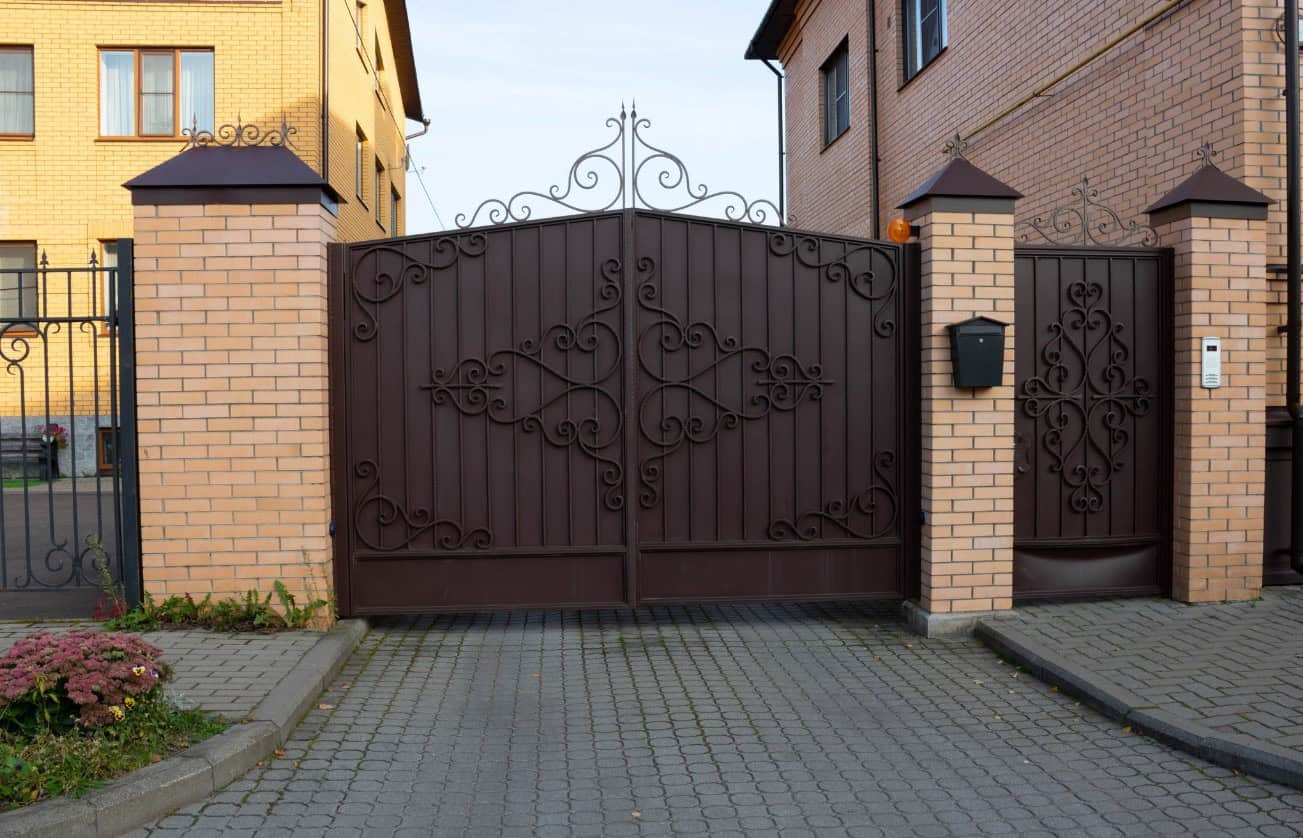Swing gate operators are essential for residential and commercial properties, enhancing security and convenience.
Understanding the safety mechanisms built into these systems ensures they operate effectively without posing risks to users or property. These mechanisms prevent accidents and ensure smooth operation under various conditions.
This article delves into the various safety features integrated into swing gate operators, from automatic sensors that detect obstructions to manual overrides for emergencies. We will explore how these features work together to provide a safe environment, maintaining the balance between security and user-friendly operation. This exploration is key to appreciating the sophistication and necessity of contemporary safety standards in automated gate systems.
Overview of Swing Gate Safety Features
The safety of swing gate operators is essential for any property owner looking to enhance their premises’ security with automated entry solutions. A well-designed swing gate system provides robust protection and ensures safe operation to prevent injuries and property damage. Understanding the swing gate safety features can help potential customers make informed decisions about their security installations. These features are built into the design of the gate operators to address common hazards associated with automatic gates.
Safety mechanisms in swing gate operators include a variety of sensors and detection systems that play a critical role in preventing accidents. For instance, pressure sensors detect when an object obstructs the gate’s path, causing the gate to stop or reverse direction, thereby reducing the risk of injury or damage.
In addition, infrared photo beams can provide an extra layer of protection by creating an invisible line across the gate’s path, which, when broken, triggers the gate to stop moving. These technologies ensure the gates are responsive and halt operation to avoid potential mishaps.
Swing gate operators also come equipped with mechanical features designed to enhance safety:
- Auto-close functions ensure the gate closes automatically after opening, minimizing the chance of unauthorized access.
- Adjustable force settings regulate the gate’s motion force to prevent excessive force that could lead to injuries.
- Emergency release mechanisms enable the gate to be opened manually in case of a power failure or system malfunction, ensuring that it does not become a safety hazard.
Educating potential customers about these safety features helps make a well-informed purchase and underscores the commitment to safety and reliability in automated gate systems. It is crucial for users to understand how these features work together to provide a seamless and secure user experience, ensuring that the technology adds value while maintaining safety at all times.
Engaging with these safety mechanisms as a key aspect of the swing gate installation process demonstrates the importance of comprehensive security solutions in today’s automated systems.
Key Components of Swing Gate Operators
Swing gate operators consist of several key components that ensure functionality and safety. The motor unit is Central to these systems, providing the necessary force to open and close the gate smoothly and efficiently. This motor must be powerful enough to handle the gate’s weight and size yet precise enough to operate within safety parameters to avoid accidents. Alongside the motor, the gearbox plays a critical role in controlling the speed and torque of the gate movement, making sure that operations are smooth and consistent.
Control panels are another vital component, acting as the brain of the swing gate operator. These panels can be programmed to accommodate varying levels of security and can include features such as timers, sensors integration, and remote control capabilities. Modern control panels also allow for connectivity with smartphones and other smart devices, allowing users to control their gates remotely and receive notifications about gate status.
Safety devices are integrated into the system to protect the property and its users. These include obstacle detection sensors, which halt or reverse the gate if an object is detected in its path, thus preventing damage or injury. Electromechanical limit switches are used to precisely control the stop points of the gate in both open and closed positions, ensuring that the gate does not exceed its intended range of motion.
These components form a comprehensive system designed to offer secure and efficient property access. By understanding the functionalities and importance of each component, potential customers can better appreciate the integration of swing gate safety features that ensure the system operates within the highest safety standards. This knowledge helps choose the right system that meets their security requirements and preferences.
Understanding Force Limits and Sensitivity Settings
Understanding the force limits and sensitivity settings is crucial for maximizing the swing gate safety features and ensuring optimal performance of swing gate operators. These settings are designed to regulate the amount of force the gate uses to move, which is essential in preventing accidents and ensuring that the gate operates safely around people and vehicles. Force limits help minimize the risk of injury or damage if someone or something comes into contact with the gate while it moves.
Force settings on swing gate operators can typically be adjusted to suit different environments and requirements. This adaptability allows for the customization of how hard or soft the gate moves, depending on the level of safety needed. For example, gates installed in residential areas where children and pets are present might be set to a lower force to prevent any potential harm in the event of an accidental touch or collision.
Sensitivity settings work in tandem with force limits. They determine how responsive the gate is to obstructions, adjusting how quickly it stops or reverses when something obstructs its path. Proper sensitivity setting calibration ensures that the gate reacts promptly to prevent accidents, providing a critical layer of safety by detecting even small obstructions in the gate’s path.
Understanding these settings is key for potential customers to ensuring that their swing gate system is safe and efficient. It allows for a tailored approach to security that meets their particular security and safety concerns. Adjusting these settings correctly can dramatically reduce the likelihood of malfunctions and accidents, highlighting the importance of professional installation and periodic maintenance to keep these settings optimized.
Manual Overrides in Emergency Situations
Manual overrides are designed to allow users to operate the gate manually if there is a power failure, system malfunction, or any other scenario that disrupts the normal functioning of the automatic mechanisms. This feature ensures that individuals can still access or secure their property during emergencies, providing a necessary backup solution that enhances overall safety.
Manual overrides are typically accessible via a physical switch or lever on the gate operator’s body. In some systems, they may also be operated remotely using specialized controls. This feature is important because it grants immediate control over the gate’s position, which is crucial in situations where waiting for technical support could compromise safety or security.
Training on how to operate these manual overrides is essential for all users. Knowing where these controls are located and how to operate them should be a part of the initial installation process, with clear instructions provided by the installers. Regular testing and maintenance should also be performed to ensure that the manual override functions correctly when needed.
For potential customers, the availability and ease of use of manual overrides are important factors to consider when choosing a swing gate system. It reassures them they have control over their property’s security, even when the automated systems fail, making it a significant selling point for those concerned with security and safety. This feature, integral to the swing gate safety features, ensures that the gate serves its purpose effectively, no matter the circumstances.
Regular Maintenance and Safety Checks
Regular maintenance and safety checks are vital to ensuring the longevity and functionality of swing gate systems. These procedures are critical not only for maintaining the mechanical and electronic integrity of the gates but also for upholding the swing gate safety features that protect users and property. Periodic inspections allow for identifying and rectifying potential issues before they lead to failures or accidents, emphasizing the importance of a proactive maintenance strategy.
Understanding the maintenance schedule recommended for their swing gate systems is essential for potential customers. This typically includes checking the mechanical parts for wear and tear, ensuring that all electronic components function properly, and verifying that safety mechanisms like sensors and manual overrides are operational. It is advisable to have a professional technician perform these checks at least annually or more frequently depending on the usage and environmental conditions.
Furthermore, regular maintenance extends beyond simple checks. It should also involve lubricating moving parts, testing electronic systems, and calibrating sensors to ensure optimal performance. Such thorough maintenance routines prevent the gradual decline in gate performance that can compromise safety and security.
Educating customers on the necessity of these practices helps them understand their role in maintaining their investment and ensuring their safety. An engaging maintenance program, coupled with professional support, can significantly enhance customer satisfaction and trust in the reliability of swing gate systems, making regular maintenance and safety checks a key selling point.
Contact R3 Access
At R3 Access, we are committed to providing exceptional support and detailed information about our swing gate operators and safety features.
Whether you are considering a new installation, need maintenance on an existing system, or simply have questions about our products, our expert team is ready to assist you. Contact us today for personalized advice and support tailored to your security needs.
We ensure responsive customer service and are dedicated to helping you enhance the safety and functionality of your access systems.
Follow Us On Linkedin
Products by Popular Manufacturers
Liftmaster: LA400PKGU
The Liftmaster LA400PKGU is a robust swing gate operator ideal for residential and light commercial use. It features advanced security features, smooth operation, and a battery backup to ensure continuous functionality even during power outages. The system is also MyQ compatible, allowing remote monitoring and control via a smartphone app.
Key Features:
- Advanced Security: Enhanced safety with secure access control.
- Smooth Operation: Reliable performance with smooth, quiet operation.
- Battery Backup: Ensures functionality during power outages.
- MyQ Compatibility: Remote monitoring and control via smartphone app.
HySecurity: SwingSmart DC 20
The HySecurity SwingSmart DC 20 is a heavy-duty swing gate operator designed for commercial and industrial applications. It boasts a powerful, efficient DC motor capable of handling large, heavy gates with ease. This operator includes advanced diagnostics, customizable settings, and solar compatibility, providing a reliable and eco-friendly solution.
Key Features:
- Powerful DC Motor: Handles large, heavy gates efficiently.
- Advanced Diagnostics: Provides real-time system health and performance data.
- Customizable Settings: Tailor the operator to specific needs and preferences.
- Solar Compatibility: Eco-friendly option with solar power support.
Viking Access: G-5 Swing Gate Operator
The Viking Access G-5 Swing Gate Operator is known for its sleek design and reliable performance. Suitable for both residential and commercial applications, it features a quiet, efficient motor, advanced safety mechanisms, and easy installation. The operator also offers smart technology integration for remote control and monitoring.
Key Features:
- Sleek Design: Modern aesthetics combined with durable construction.
- Quiet Motor: Efficient operation with minimal noise.
- Advanced Safety Mechanisms: Enhanced protection features for secure operation.
- Smart Technology Integration: Remote control and monitoring capabilities.


